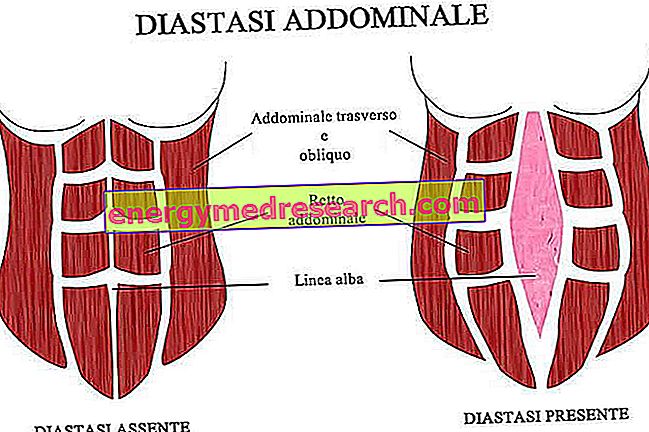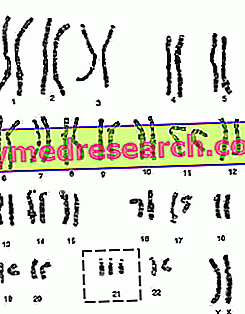Generality
Abdominal diastasis is the excessive separation of the right side from the left side of the rectus abdominal muscle.
Abdominal diastase episodes generally involving newborns and pregnant women.
In the first case, the condition is due to incomplete development of the abdominal rectus muscle; in the second case, instead, it is due to the stretching of the rectus abdominal muscle, operated from the inside by the uterus in continuous growth.
The characteristic sign of the abdominal diastase is a longitudinal crest, which goes from the xiphoid process of the sternum to the navel.

Figure: abdominal rectus muscle and linea alba. - From the site: www.ipphysio.com
Usually, for a correct diagnosis of abdominal diastase, a physical examination is sufficient.
In most cases, the abdominal diastase resolves spontaneously, without any treatment. However, in some cases the intervention of the surgeon may be indispensable. In the case of newborns, surgical treatment consists of an umbilical or ventral hernia surgery; in the case of pregnant women, surgery consists of abdominoplasty.
Brief anatomical recall of the abdominal rectus muscle
The abdominal rectus muscle, or simply the abdominal rectum, is one of the main muscles of the anterior abdominal wall.
It is an equal muscular element: this means that there is a right abdominal right muscle and a left abdominal rectus muscle.
The right abdominal rectum and the left abdominal rectum are very close together; to separate them is the so-called linea alba (or midline ), which is a thin band of connective tissue, devoid of nerves and blood vessels and with longitudinal development from just below the sternum to the bones of the pelvis.
The rectus abdominal muscle originates from the superior margin of the pubis, between the pubic crest and the pubic tubercle, and finds insertion at the level of the xiphoid process of the sternum and in the rib cartilage of the V, VI and VII rib cage .
What is abdominal diastase?
Abdominal diastase, also known as diastasis of the abdominal rectum, is the separation of the right abdominal rectus muscle from the left abdominal rectus muscle.
To be precise, the doctors talk about abdominal diastasis, when the right abdominal rectus muscle distances itself from the left abdominal rectus muscle by at least 2.7 centimeters.
Causes
Abdominal diastase is a condition that affects mainly newborns and pregnant women .
In newborns, the cause of abdominal diastasis is the poor development of the rectus abdominal muscle; poor development which is the reason for a lack of close proximity, at the level of the linea alba, between the right muscular element and the left muscular element.
In pregnant women, the cause of abdominal diastasis is the excessive stretching of the rectus abdominal muscle, induced by the expansion of the uterus; in other words, the growth of the uterus, due to the increasingly large fetus, involves an internal pressure on the abdominal rectus muscle, such that the separation of the right muscular element from the left muscular element takes place.
RISK FACTORS
Risk factors for abdominal diastasis in the newborn include: belonging to the African-American race and premature birth.
Among the risk factors of abdominal diastasis of pregnant women, however, deserve a special mention:
- Age over 35;
- A fetus of high weight;
- A multiple pregnancy (NB: for multiple, s'intende twin);
- A past history of other pregnancies.
Symptoms, signs and complications
The characteristic sign of abdominal diastasis is a sort of crest that forms at the linea alba and goes from the xiphoid process of the sternum to the navel.
To make the aforementioned crest particularly evident is the muscular tension of the muscles of the abdomen.
SIGNS IN THE NEWBORN
In newborns, the crest that characterizes the abdominal diastasis is easily recognizable, especially when the patient tries to get into a sitting position.
The relaxation of the abdomen by children with abdominal diastasis makes it possible to feel the edges of the rectus abdominal muscle.
SIGNS IN THE PREGNANT WOMAN
In pregnant women, the crest resulting from the abdominal diastasis is not very evident at the beginning of pregnancy, while it tends to become particularly visible during the last months of gestation. In the first months of pregnancy, it appears only as an excess of skin and soft tissues; at the end of gestation, on the other hand, it manifests itself as a real protuberance: this protuberance is due to the uterus which, pushing on the rectus abdominal muscle from the inside, has found a way to escape from an opening along the alba line.
Sometimes, where the portion of the uterus comes out, it is possible to see the fetus.
COMPLICATIONS
The complications of an abdominal diastase concern only newborns and consist in the formation of an umbilical or ventral hernia .
The typical symptomatology of an umbilical or ventral hernia, deriving from a ventral diastasis episode, consists of:
- He retched;
- Abdominal redness;
- Abdominal pain.
Diagnosis
In general, doctors diagnose abdominal diastasis through physical examination only.
The physical examination is the set of diagnostic maneuvers, carried out by the doctor, to verify the presence or absence, in the patient, of signs indicative of an abnormal condition.
If there are doubts, the use of ultrasound clarifies any doubts.
WHAT CONDITIONS MAY LOOK TO THE ABDOMINAL DIASTASIS?
Doctors resort to ultrasound examination when they have the doubt that the signs present are due to an epigastric hernia or to a particular abdominal hernia, called laparocele .
Therapy
In pregnant women, abdominal diastasis usually does not require treatment. The only exceptions concern the cases of women who have been the protagonists of different pregnancies and need a suture of the linea alba, damaged due to the stretching of the rectus abdominal muscle. In such cases, the therapy is surgical and consists of an abdominoplasty operation .
Moving on to newborns with abdominal diastases, the general tendency is that the problem resolves spontaneously, without any treatment; however, if an umbilical or ventral hernia appeared, it would be necessary to intervene surgically.
The use of surgery for an abdominal diastasis of the child is a very rare event, as the onset of complications due to the condition is rare.
SPONTANEOUS RESOLUTION OF THE ABDOMINAL DIASTASIS IN PREGNANT WOMEN
As a rule, the separation of the rectus abdominal muscle resolves within the first 8 weeks following the birth.
According to some experts, it is possible to speed up the resolution process by using some physiotherapy exercises.
Prognosis
In most cases, abdominal diastasis has a positive prognosis.
In fact, in women who have given birth, it is not common to have a problem for more than 8 weeks, while in newborns, the onset of dangerous hernias is rare.
Prevention
At the moment, there are no known behaviors or precautions that avoid the onset of abdominal diastasis.



